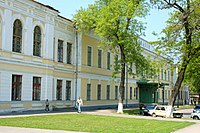Chekhov Gymnasium
| Литературный музей им. А.П.Чехова | |

Chekhov Gymnasium in 2006
|
|
| Established | 1809 (as gymnasium) 1975 (as museum) |
|---|---|
| Location | Ulitsa Oktyabrskaya 9, Taganrog |
| Collection size | Expositions related to Anton Chekhov's school years, theater plays by Chekhov (memorabilia, photographs) |
| Director | Yelizaveta Vasilievna Lipovenko Липовенко, Елизавета Васильевна |
| Public transit access | Spartakovsky Station (Street cars: 2,3,5,8,9) |
The Chekhov Gymnasium in Taganrog on Ulitsa Oktyabrskaya 9 (formerly Gymnasicheskaya Street) is the oldest gymnasium in the South of Russia. Playwright and short-story writer Anton Chekhov spent 11 years in the school, which was later named after him and transformed into a literary museum. Visitors can see Anton's desk and his classroom, the assembly hall and even the punishment cell which he sometimes visited.
The Boys Gymnasium was founded in 1809 and this building was completed in 1843 by the plans of the Italian architect Francesco Boffo. Students of the Boys Gymnasium benefited from various grants, most of them being introduced by the Greek-Russian merchant and benefactor Ioannis Varvakis (1745–1825). In mid-1870s a school church was made in the same building, and the cross may be seen on some old postcards.
After the Russian Revolution of 1917 and the following Civil War, the building housed a cavalry school (6th Cavalry College), frequently visited by Semyon Budyonny, Klim Voroshilov and Efim Shadenko.
During the Occupation of Taganrog in 1941-1943 used by the Germans as Sicherheitsdienst headquarters.
In 1954, the Boys Gymnasium was named after Anton Chekhov within the framework of events dedicated to the writer's 50th death anniversary memorial year.
In 1975 opened as The Literary Museum named after Anton Chekhov, more commonly known under the short name Chekhov Gymnasium.
January 29, 2010 President of Russian Federation Dmitri Medvedev held a meeting with representatives of the Russian and foreign theatrical communities in Taganrog at the stateroom of the Chekhov Gymnasium literary museum.
Anton Chekhov attended a school for Greek boys in Taganrog (1866-1868), and at the age of eight he was sent to the local grammar school (Gymnasium) where he proved an average pupil. Rather reserved and undemonstrative, he nevertheless gained a reputation for satirical comments, for pranks, and for making up humorous nicknames for his teachers. He enjoyed playing in amateur theatricals and often attended performances at the Taganrog Theatre. As an adolescent he tried his hand at writing short "anecdotes," amusing or funny stories, although he is also known to have written a serious long play at this time, "Fatherless," which he later destroyed. He received an annual grant of 300 rubles which had been introduced by the Taganrog City Council after the failed assassination attempt on the tsar Alexander II of Russia.
...
Wikipedia
